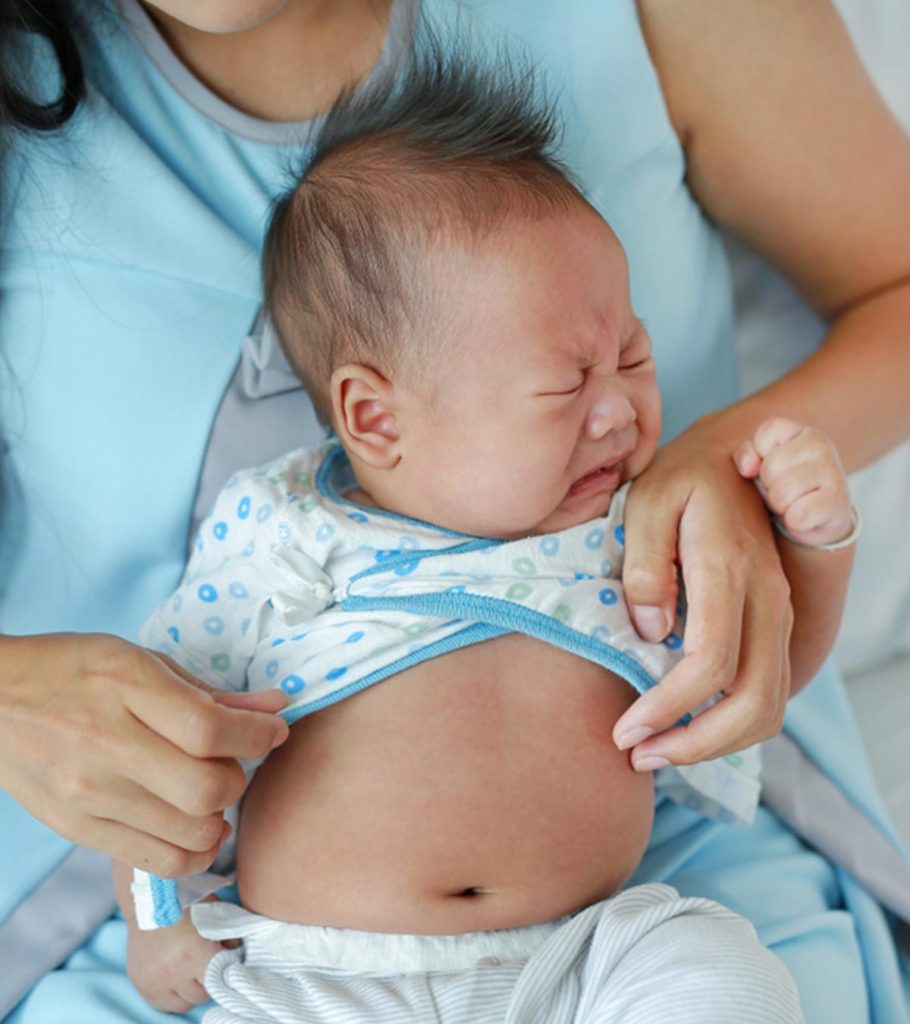Image: Shutterstock
Food protein-induced enterocolitis syndrome (FPIES), also called dietary protein enterocolitis, is a rare type of food allergy that affects the gastrointestinal tract. Its symptoms may take a few hours to occur after the consumption of triggering food.
Babies and young children are more likely to develop FPIES, and the triggering food may vary in each baby. FPIES may cause profuse vomiting and diarrhea due to inflammation of the intestinal tract. Seek medical care to avoid severe complications such as dehydration and hypovolemic shock.
Read this post to know more about the causes, common triggering foods, signs, symptoms, diagnosis, and management of FPIES in babies.
Causes Of FPIES In Babies
The exact cause of FPIES is unknown. The improper response of the immune response to food proteins can cause an allergic reaction and localized inflammation of the intestines. FPIES is not an IgE-mediated reaction, unlike other food allergies. Babies with a family history of atopic disorders are more likely to develop FPIES than others (1).
The syndrome is usually seen in babies who have begun consuming solids. FPIES in exclusively breastfed babies is rare. Although various foods could trigger FPIES, the following foods are common triggers in many babies (2).
- Cow milk and other dairy products
- Soy milk and other soy products
- Cereal grains such as rice, corn, barley, and oats
- Chicken
- Eggs
- Turkey
- Fish and mollusks
- Green beans
- Sweet potatoes
- Squash
- Peas
- Mushrooms
- Probiotics
Signs And Symptoms Of FPIES In Babies
The severity, signs, and symptoms of FPIES may vary in each baby.
The following are the common signs and symptoms of FPIES in babies (3).
- Vomiting
- Diarrhea, often with blood
- Pallor (pale appearance)
- Dehydration
- Lethargy (sleepy appearance)
- Distended abdomen
- Reduced body temperature (hypothermia)
- Low blood pressure (hypotension)
- Cyanosis (bluish skin)
- Thrombocytosis (increased platelets)
- Hypovolemic shock (insufficient fluids in the body)
Dehydration, low blood pressure, low body temperature, and hypovolemic shock requires emergency medical care.
Diagnosis Of FPIES
Diagnosis of FPIES can be challenging since the food allergy may occur a few hours after the consumption of the triggering food. And, by the time the symptoms develop, babies may have eaten other foods, too. Some food items can contain multiple ingredients, and any of those could trigger FPIES (4).
Blood tests during an ongoing reaction could help diagnose FPIES. Supervised oral food challenge tests in a hospital may help identify trigger foods. Standard allergy tests, including blood test or skin prick test (SPT) to measure food IgE antibodies, may not be useful in diagnosing FPIES.
FPIES may mimic the signs and symptoms of sepsis in many babies. Therefore, pediatricians may order tests to exclude this condition.
Treatment Of FPIES
The following treatments are generally considered for babies with FPIES (5).
- Replace dairy and soy-based infant formula with elemental formula or hypoallergenic formula, such as casein hydrolysate-based formula.
- Introduce vegetables and fruits instead of cereals and grains if the baby already has FPIES.
- Introduce one food at a time and wait for three to five days before introducing a new food. Giving one type of food may make it easier to identify the allergen than mixed recipes.
- Identify and avoid the foods that trigger the symptoms.
- Steroid treatments are given to reduce the immune reaction.
- IV fluids are given if the baby has dehydration due to vomiting or diarrhea.
- If a breastfed baby has FPIES, they should be given formula feed.
The treatment options may vary based on the severity of symptoms and the FPIES-triggering food. Pediatricians, allergists, gastroenterologists, and feeding therapists may be involved in babies’ care. It is recommended to seek personalized diet plans since the triggering food may vary in each baby.
These treatment options are aimed at managing the symptoms and reducing the severity of allergic reactions. There is no specific treatment for the condition, so identifying and avoiding triggers on an individual basis is recommended.
Prognosis Of FPIES In Babies
Most babies remain healthy and have normal growth if they are not fed triggering foods. Many babies outgrow FPIES at an early age, and it is not a lifelong condition. Recent studies have shown that most babies with FPIES caused by barley, dairy, or rice outgrow the condition by age three (5). Oral food challenges are often conducted with medical supervision to identify if the baby has outgrown the FPIES.
Some babies may experience FPIES in adolescence and beyond. Proper medical care and a personalized diet plan could help ensure adequate growth in such cases.
Babies with FPIES may have a higher risk of developing atopic disorders, including atopic dermatitis (a chronic inflammatory disorder of the skin), asthma, and allergic rhinitis (hay fever). There might also be a risk of developing gastroesophageal reflux. You may discuss with the pediatrician the prognosis of FPIES specific to your baby.
FPIES in babies may limit the foods babies can eat. Avoid feeding the allergenic food unless the doctor confirms that the baby has outgrown FPIES. Proper medical care could help reduce the risk of severe symptoms. Also, personalized diet plans can ensure that the baby does not miss out on nutrients and has a healthy growth.
